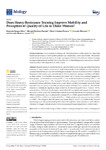Mostrar o rexistro simple do ítem
Does Heavy-Resistance Training Improve Mobility and Perception of Quality of Life in Older Women?
| dc.contributor.author | Borges-Silva, Fernanda | |
| dc.contributor.author | Martínez-Pascual, Miryam | |
| dc.contributor.author | Colomer Poveda, David | |
| dc.contributor.author | Márquez, Gonzalo | |
| dc.contributor.author | Romero-Arenas, Salvador | |
| dc.date.accessioned | 2022-06-09T13:47:04Z | |
| dc.date.available | 2022-06-09T13:47:04Z | |
| dc.date.issued | 2022-04-20 | |
| dc.identifier.citation | Borges-Silva, F.; Martínez-Pascual, M.; Colomer-Poveda, D.; Márquez, G.; Romero-Arenas, S. Does Heavy-Resistance Training Improve Mobility and Perception of Quality of Life in Older Women? Biology 2022, 11, 626. https://doi.org/10.3390/biology11050626 | es_ES |
| dc.identifier.issn | 2079-7737 | |
| dc.identifier.uri | http://hdl.handle.net/2183/30864 | |
| dc.description.abstract | [Abstract] Regular physical exercise has shown great benefits in preventing age-related functional losses and in improving the perception of health-related quality of life (HRQoL) in older people. To optimize these benefits, it would be interesting to evaluate what type of exercise is better. Therefore, the purpose of this study was to assess the effects of heavy-resistance training on mobility and HRQoL in older women. Forty healthy, untrained older women (60–75 years) were randomly assigned to three groups: circuit resistance training (CRT, n = 15), traditional resistance training (TRT, n = 15) or the control group (CG, n = 10). During the 12-week training period, both experimental groups performed training with heavy loads, twice a week. Before and after the training period, the Timed Up and Go test, as a proxy of mobility, and the perception of HRQoL were evaluated. TRT and CRT resulted in a statistically significant improvement in the Timed Up and Go test (−5.4 and −10.3%, respectively; p < 0.05), but only the improvement after CRT was significantly greater than changes in the CG (p < 0.001). Only CRT elicited improvements in several dimensions of the perception of the HRQoL questionnaire, such as: physical functioning (13%, p < 0.001), general health (8.1%; p = 0.048), vitality (17.7%; p < 0.001), role emotional (6.7%; p = 0.044) and physical component summary (6.3%; p = 0.001). The change in the CRT group was greater than in the CG (p < 0.001) in the physical functioning score. The present findings show that CRT might be a time- (and hence cost-) effective alternative to trigger multiple positive functional and psychological adaptations in older women. | es_ES |
| dc.description.sponsorship | This work was supported by the grants from Fundación San Antonio, reference n: PMAFI-10/21 | |
| dc.description.sponsorship | Fundación Universitaria San Antonio (Murcia); PMAFI-10/21 | |
| dc.language.iso | eng | es_ES |
| dc.publisher | MDPI | es_ES |
| dc.relation.uri | https://doi.org/10.3390/biology11050626 | es_ES |
| dc.rights | Atribución 4.0 Internacional | es_ES |
| dc.rights.uri | http://creativecommons.org/licenses/by/4.0/ | * |
| dc.subject | Activities of daily living | es_ES |
| dc.subject | Mobility | es_ES |
| dc.subject | Resistance training | es_ES |
| dc.subject | Training intervention | es_ES |
| dc.subject | Walking speed | es_ES |
| dc.subject | Actividades da vida diaria | es_ES |
| dc.subject | Mobilidade | es_ES |
| dc.subject | Adestramento da resistencia | es_ES |
| dc.subject | Intervención do adestramento | es_ES |
| dc.subject | Velocidade da marcha | es_ES |
| dc.subject | Actividades de la vida diaria | es_ES |
| dc.subject | Movilidad | es_ES |
| dc.subject | Entrenamiento de la resistencia | es_ES |
| dc.subject | Intervención del entrenamiento | es_ES |
| dc.subject | Velocidad de la marcha | es_ES |
| dc.title | Does Heavy-Resistance Training Improve Mobility and Perception of Quality of Life in Older Women? | es_ES |
| dc.type | info:eu-repo/semantics/article | es_ES |
| dc.rights.access | info:eu-repo/semantics/openAccess | es_ES |
| UDC.journalTitle | Biology | es_ES |
| UDC.volume | 11 | es_ES |
| UDC.issue | 5 | es_ES |
| UDC.startPage | 626 | es_ES |
Ficheiros no ítem
Este ítem aparece na(s) seguinte(s) colección(s)
-
GI- ACOM - Artigos [18]






